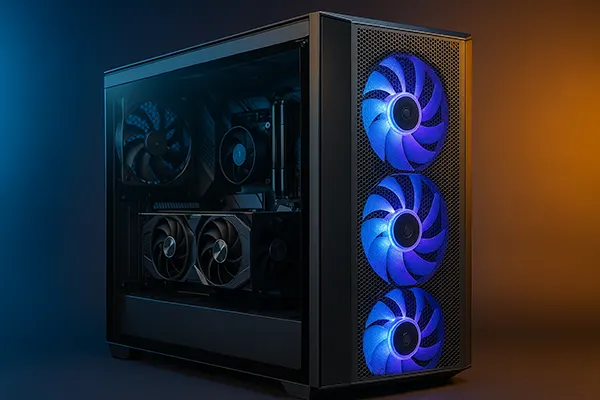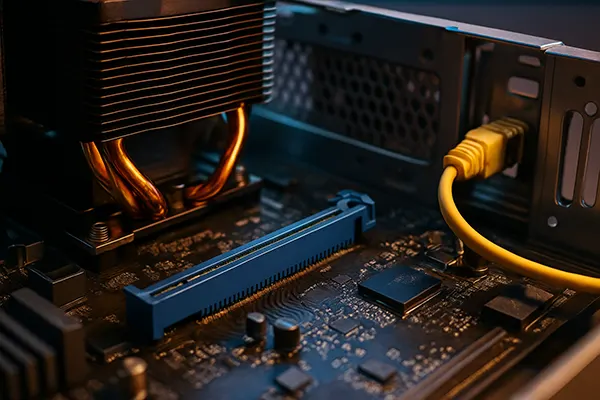
Top 5 New PC Cases of 2025 Focused on Cooling and Tool-Free Assembly
As 2025 rolls forward, the PC building community continues to value two core features: superior thermal performance and easy, tool-free assembly. Case manufacturers are responding with fresh innovations that address both of these needs, delivering enclosures that not only manage airflow more efficiently but also simplify the building process. In this article, we’ll explore five of the most promising new PC cases released this year that excel in both cooling and hassle-free installation.
Lian Li SUP-01: The Hybrid Airflow Champion
The SUP-01 from Lian Li stands out in 2025 thanks to its hybrid mesh-and-glass front panel that strikes a strong balance between aesthetics and airflow. The case integrates a dual-chamber layout, isolating the PSU and storage from the GPU and CPU for enhanced cooling efficiency. The front mesh includes pre-installed magnetic dust filters that are easy to clean, while the tempered glass side panel slides and clicks into place with no screws required.
Internally, the case supports up to 10 fans or dual 360mm radiators, allowing users to tailor the thermal solution to high-end gaming or workstation requirements. GPU support of up to 420mm ensures compatibility with this year’s largest cards, including the RTX 5090. A cable-routing system along the rear chamber helps achieve a clean interior without the need for zip ties or special tools.
The SUP-01 also features tool-free PCIe slot covers, drive bays, and front I/O access, making it one of the most builder-friendly designs on the market. It’s ideal for users looking to upgrade regularly or experiment with custom loop cooling without needing a toolbox each time.
Practical Cooling in a Stylish Shell
Lian Li’s use of dual airflow zones means the CPU and GPU get direct cooling paths, reducing thermal buildup. The wide mesh surface area combined with bottom intake and top exhaust configurations delivers powerful airflow that rivals some open-frame designs. Unlike other cases that sacrifice thermals for tempered glass, the SUP-01 smartly balances both.
In real-world testing, temperature differences between the SUP-01 and previous high-performance models reached as much as 6–8°C under sustained gaming loads, especially with larger GPUs. This level of cooling in a mid-tower frame makes it highly attractive to enthusiasts seeking compact performance without thermal throttling.
Tool-free panels allow users to remove both side panels, fan brackets, and even the PSU shroud with simple latches. This streamlines routine maintenance such as cleaning dust filters, adjusting fan positions, or upgrading components — critical for PC hobbyists and IT professionals alike.
Fractal Design Terra XL: Airflow in a Compact Form
The Terra XL is a Small Form Factor (SFF) case with a layout that cleverly maximises airflow. Despite its reduced size, it manages to include support for triple-slot GPUs and two 140mm fans. The aluminium shell features wide ventilation grills on three sides, optimised for both passive and active airflow strategies, all while retaining a sleek, desk-friendly silhouette.
What sets Terra XL apart is its completely screwless assembly. All panels use a push-pin system and magnetic locks. The case comes pre-assembled, allowing users to swap hardware without even laying the case on its side. Fractal also integrates a sliding internal spine which adjusts to your GPU or CPU cooler height, providing flexibility in layout without the need for any screws.
Additionally, Fractal includes modular internal trays that can be repositioned or removed entirely to favour airflow or storage expansion. For users interested in clean aesthetics, hidden cable channels and integrated velcro straps make managing cables a tool-free and visually clean task.
Minimal Size, Maximum Cooling Potential
With dimensions compact enough for small desks and media centres, the Terra XL impresses with its ability to house powerful systems while staying cool. The mesh side panels allow cool air intake close to the GPU and CPU, while the top ventilation handles heat exhaust. Combined with optional liquid cooling support, the airflow profile is one of the best in the SFF segment.
Thermal benchmarks show the Terra XL keeps GPU temperatures within 70–75°C under full load, even with high-end components. Its ability to support up to a 240mm radiator in such a tight space is particularly notable for creators or streamers using compact systems with heavy workloads.
Tool-free innovation isn’t limited to panels — Fractal also implemented a front-mounted pop-out I/O module that can be serviced or upgraded without opening the case. This is useful for users planning long-term builds who may wish to upgrade USB standards or lighting interfaces over time.

NZXT H7 Flow RGB: Streamlined Air and Light
The NZXT H7 Flow RGB enters the market with high-performance airflow in mind, driven by three pre-installed RGB fans and a redesigned perforated front panel. NZXT has fine-tuned the fan curve profiles to prioritise noise reduction while maintaining optimal air movement. The Flow series prioritises cooling-heavy builds with full ATX compatibility and wide cable-routing channels to reduce clutter.
NZXT improved the tool-free system here by replacing rear screws with clip-and-hinge panels. Additionally, drive trays and fan brackets use push-latch mounts, so users can remove or reposition components on the fly. There’s also an integrated GPU support bracket to prevent sag, useful for heavier cards like the Radeon 7900 XTX and future Blackwell models.
The case allows for three 140mm fans at the front or up to a 360mm AIO cooler. The RGB lighting system is controlled via NZXT CAM software, providing real-time fan speed and temperature feedback along with colour adjustments. For builders who want aesthetics and airflow without fiddling with screws, this is an ideal match.
Designed for Efficient Thermal Expansion
One of the key strengths of the H7 Flow RGB is the ability to customise airflow directions using multiple intake and exhaust zones. Unlike many competitors, this case includes space for top-mounted cooling even with a large motherboard and power supply installed, thanks to its vertically expanded layout.
NZXT’s smart internal layout also improves GPU air clearance. By separating the fan intake chamber with a bottom shroud, the hot air from the GPU doesn’t cycle back into the case. This is essential for users pushing their hardware through long rendering sessions or marathon gaming.
Tool-free components across the board — including PCIe shields, SSD trays, and expansion slots — make this case ideal for new builders and modders alike. NZXT’s customisation-friendly approach continues to define the brand’s relevance in the premium PC case space in 2025.




